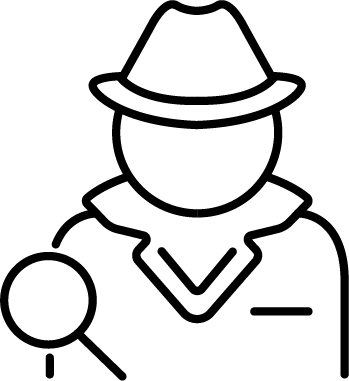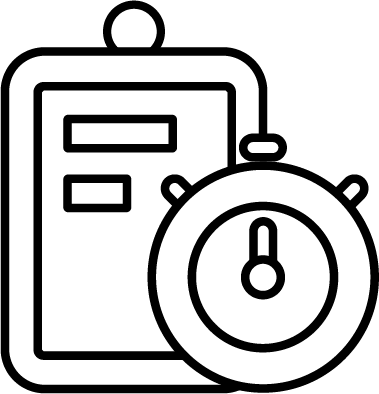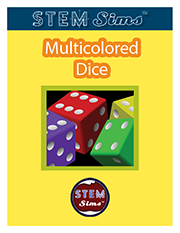What is probability?
Probability is the chance or likelihood of an event happening. For example, coins have two sides, a head and a tail. The probability of getting a head is 1/2 because there are two possible choices. But notice that getting a tail is the same probability because there is an equal chance of getting either a head or a tail.
How does probability work?
The formula for the probability of an event is:
P(event) = The number of ways the event can occurThe total number of possible outcomes
For dice roll, if you wanted to know the probability of the die landing on a 1 is:
P(1) = # ways to land on a headTotal # of sides
= 16
The probability of rolling any number on a die is the same! You have the same probability of rolling a 3 as you do a 5. If there was a customized rigged die where a 1 replaced the 2 spot, the probability of getting a 1 would increase to 2/6 or 1/3 because there are now two ways to land on the 1.
You can also find the probability of more than one variable occurring together. The formula for the probability of event A and B happening together is:
P(A and B) = P(A) × P(B)
For example, if you wanted to get a 12 with two dice, the probability of getting a 6 on each die is:
P(6 on first die) = 1/6
P(6 on second die) = 1/6
P(6 on first die AND 6 on second die) = 1/6 × 1/6 = 1/36
You can also combine the probabilities if you are looking for the probability of multiple variables that could happen. The formula for the probability of event A or B happening is:
P(A or B) = P(A) + P(B)
For example, if you wanted to roll a 5 or a 6 on a die, the probability is:
P(5) = 1/6
P(6) = 1/6
P(5 or 6) = 1/6 + 1/6 = 2/6 = 1/3
In combination of all the probability rules, if you had two dice and wanted to find the probability of rolling an 8:
There are multiple ways of getting an 8:
(2 and 6) or (3 and 5) or (4 and 4) or (5 and 3) or (6 and 2)
The probability of rolling a specific number on the first die is 1/6 and the probability of rolling a specific number on the second die is 1/6. The probability of getting the combination of the two dice together is the probability of the first die multiplied with the probability of the second die.
P(2 and 6) = 1/36
P(3 and 5) = 1/36
P(4 and 4) = 1/36
P(5 and 3) = 1/36
P(6 and 2) = 1/36
The probability of rolling any of those combinations is added together:
1/36 + 1/36 + 1/36 + 1/36 + 1/36 = 5/36
How can probability be expressed?
Probabilities can be expressed as a decimal, fraction, or percent. The probability will be the same even if expressed in different ways. The possibility of a coin landing on heads is 50%, 1/2, or 0.50.
Some fractions do not divide as easily as others like 1/2, so it might look best to leave in the fraction form. For example, the possibility of pulling a heart from a deck of cards is 1/13 or 0.076923 or 7.69%. For 1/13, the decimal and percentage was rounded which could later lead to imprecision if you used the number in multiple calculations.
Probability is always between 0 and 1 because the number of ways an event can occur can never exceed the total number of total outcomes. Even if you had a trick coin that had two heads, the probability of getting a head is 2/2=1.
What is statistics?
Statistics is the science of the collection, interpretation, and analysis of numerical data. Statisticians have to design experiments for the best way to collect data. Using the data they collected, statisticians summarize the information and draw conclusions to estimate the present or predict the future. In 1956, Oliver Lancaster, an Australian statistician, made an observation that the rate of skin cancer in Australia was strongly correlated with latitude (and the amount of sunlight received). His observation was one of the first links between skin cancer and the exposure to sunlight.
What is statistics used for?
Statistics is used to make predictions to understand processes better. By using probabilities to calculate chance along with the data collected, statistics is used in a wide range of subjects like medicine, psychology, marketing, sports, and economics just to name a few.
What is the birthday problem?
How likely is it that two people in a class share the same birthday? This is the birthday problem. Because the birthdays all have to be on a different day from everybody else's, the best approach to ask the question what is the probability that no two people will share a birthday. As the number of people increase, the smaller the probability is that all of them will have different birthdays.
What is the Pigeonhole Principle?
The pigeonhole principle states that if the number of items is greater than the number of pigeonholes, then at least one pigeonhole will contain more than one item. If you had a drawer with 5 pairs of black socks and 6 pairs of white socks, how many socks would you have to pick out to have a pair? The answer to this question is 3. If the first two socks you pick out are black and white, the next sock will be either black or white which will make a pair. Another example is that if you pick five cards from a deck, there will be at least two cards with the same suit. This seems intuitive, but its applications can be applied in harder problems and is useful in equations.
How is the Pigeonhole Principle applied to probability?
The pigeonhole principle is applied to probability because the pigeons have a uniform probability of 1/number of pigeonholes. Even if the pigeons are placed into the pigeonholes with the same probability, it could still be placed in one that is occupied, and the probability increases as the number of pigeons increases. For example, if there are 2 pigeons and 4 pigeonholes, the probability is 25% that a pigeonhole will hold more than one pigeon. For 5 pigeons and 10 pigeonholes, the probability increases to about 70%, and for 10 pigeons and 20 holes, the probability increases to about 93%.
 If ten people are in a room, what is the chance that two of them share the same birthday? If you’re playing a dice game, which combinations do you have a higher chance of rolling? These types of questions can be answered using the laws of probability. Your challenge is to use probability to determine optimal combinations of people or cards to achieve a desired result.
If ten people are in a room, what is the chance that two of them share the same birthday? If you’re playing a dice game, which combinations do you have a higher chance of rolling? These types of questions can be answered using the laws of probability. Your challenge is to use probability to determine optimal combinations of people or cards to achieve a desired result.

